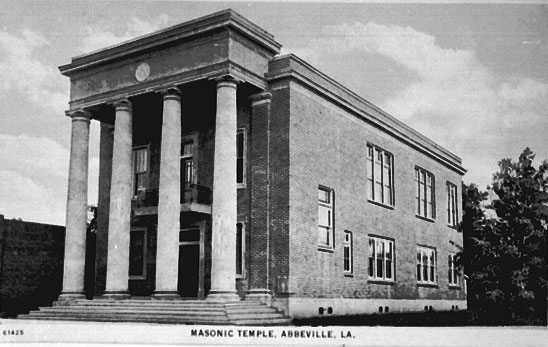
 The
Masonic Temple
The
Masonic Templeby Kenneth A. Dupuy

[After the courthouse fire of April 7, 1885, the Abbeville Masonic Lodge No. 192 purchased the lot upon which the current Masonic Temple is situated. The Police Jury made a contract with the Masons to build a temporary courthouse on that lot and use it until a permanent courthouse could be built, which was done in 1892-93.]
This Masonic Hall, built in 1885, came down thirty-seven years later. In July 1922, demolition began, virtually across the street from the much older Veranda Hotel. On September 4, 1922, the new building, though incomplete, was ready for the laying of the cornerstone. Following a meeting of the lodge, at a site unspecified by the newspaper, Abbeville's lodge members and representatives from lodges at Crowley, St. Martinville, Lafayette, Lake Arthur, and New Iberia marched to the "New Temple." The cornerstone was laid then "according to custom of the ancient order of Free & Accepted Masons."
On June 23, 1923, the Abbeville Progress published a photo of the new Masonic Temple, and reported that its construction had cost $20,000. It was described as being "the finest Masonic Temple between the cities of Lake Charles and New Orleans." Dedication ceremonies were held on St. John's Day, June 24, 1923. St. John's Day has a special significance for Masons—I've noticed it associated with other Masonic activities, over the years. For example, the excursion aboard the Barmore, on June 24, 1885, was under the auspices of the "Masonic fraternity" of Abbeville. In fact, this excursion is the one that we took together on another "Journey into the Past," several years ago.
Despite inclement weather and poor road conditions—our parish, if not most of Louisiana, still had unpaved highways—representatives from many lodges drove to Abbeville to partake in the dedication ceremonies. The names of many of these visitors were reported by the Abbeville Progress. It also listed the names of at least 75 local Masons who had registered that day, as well as the names of the others who were not in attendance. I will note only the names of Abbeville's officers. They were J. H. Williams, F. C. Stebbins, Abbot J. Hayes, H. A. Broussard, W. S. Hayes, S. O. Olivier, W. W. Durke, Lloyd B. Miller, M. M. Fletcher, W. W. Montagne, Harry Schriefer, and Max Harrel.
Following a session of the Grand Lodge at the courthouse, the dedication ceremonies were then held at our new temple. J. H. Williams, according to the Abbeville Progress, as "Master of Abbeville Lodge, presented the building to the Grand Lodge for dedication." The "working tools," according to "Masonic tradition," were used in these rites. They were: (1) "a vessel of corn" which was used to dedicate the temple to "usefulness," (2) a vessel of wine which was used to dedicate it to "virtue," and (3) a vessel of oil which was used to dedicate the temple to the "universal benevolence."* These dedication activities, which were open to the public, were performed inside the temple. Following these rites, everyone then returned to the courthouse for yet another speech.
Throughout this glorious day, the Masons, their families and friends consumed "delicious refreshments and good eats that were served on the lower floor of the Temple," according to the Progress. It credited the food and refreshments to the "ladies of the Eastern Star and the wives of the members of the Masonic Lodge." I've noticed in this instance and in others that it was a good thing that Abbeville had more than one newspaper during those years. While the Progress gave the dedication of the Masonic Temple major coverage, the Meridional hardly reported on it at all. Naturally, the reverse, in extent of coverage, has been the case in other situations.
This building continues to serve the Masons as well as the public. At one time it was used by the community as our library. When the current courthouse was constructed, this Masonic Temple was turned into a temporary courthouse, as had been the previous Hall. It housed the offices of the clerk of court, the sheriff, and the assessor, from January 1951 until February 1953.
by Ken Dupuy
* Editorial note: The reporter was somewhat confused. The "Masonic working tools" are exactly what the words imply, namely, the tools used by brickmasons—including the level, plumb, compasses, gavel, square, trowel, and gauge, all of which have symbolic meaning to the members of the Masonic fraternity. The working tools have nothing to do with vessels of corn, wine, and oil.